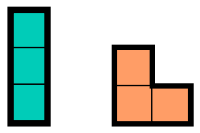Tromino

A tromino is a polyomino of order 3, that is, a polygon in the plane made of three equal-sized squares connected edge-to-edge.[1]
Symmetry and enumeration
When rotations and reflections are not considered to be distinct shapes, there are only two different free trominoes: "I" and "L" (the "L" shape is also called "V").
Since both free trominoes have reflection symmetry, they are also the only two one-sided trominoes (trominoes with reflections considered distinct). When rotations are also considered distinct, there are six fixed trominoes: two I and four L shapes. They can be obtained by rotating the above forms by 90°, 180° and 270°.[2][3]
Rep-tiling and Golomb's tromino theorem
.gif)
Both types of tromino can be dissected into smaller trominos of the same type, for any integer . That is, they are rep-tiles.[4] Continuing this dissection recursively leads to a tiling of the plane, which in many cases is an aperiodic tiling. In this context, the L-tromino is called a chair, and its tiling by recursive subdivision into four smaller L-trominos is called the chair tiling.[5]
Motivated by the mutilated chessboard problem, Solomon W. Golomb used this tiling as the basis for what has become known as Golomb's tromino theorem: if any square is removed from a chessboard, the remaining board can be completely covered with L-trominoes. To prove this by mathematical induction, partition the board into a quarter-board of size that contains the removed square, and a large tromino formed by the other three quarter-boards. The tromino can be recursively dissected into unit trominoes, and a dissection of the quarter-board with one square removed follows by the induction hypothesis. In contrast, when a chessboard of this size has one square removed, it is not always possible to cover the remaining squares by I-trominoes.[6]
References
- ↑ Golomb, Solomon W. (1994). Polyominoes (2nd ed.). Princeton, New Jersey: Princeton University Press. ISBN 0-691-02444-8.
- ↑ Weisstein, Eric W. "Triomino". MathWorld.
- ↑ Redelmeier, D. Hugh (1981). "Counting polyominoes: yet another attack". Discrete Mathematics. 36: 191–203. doi:10.1016/0012-365X(81)90237-5.
- ↑ Niţică, Viorel (2003), "Rep-tiles revisited", MASS selecta, Providence, RI: American Mathematical Society, pp. 205–217, MR 2027179.
- ↑ Robinson, E. Arthur, Jr. (1999). "On the table and the chair". Indagationes Mathematicae. 10 (4): 581–599. doi:10.1016/S0019-3577(00)87911-2. MR 1820555..
- ↑ Golomb, S. W. (1954). "Checker boards and polyominoes". American Mathematical Monthly. 61: 675–682. doi:10.2307/2307321. MR 0067055..
External links
- Golomb's inductive proof of a tromino theorem at cut-the-knot
- Tromino Puzzle at cut-the-knot
- Interactive Tromino Puzzle at Amherst College